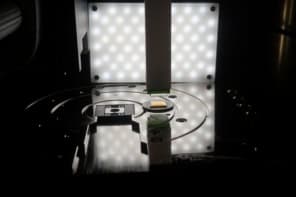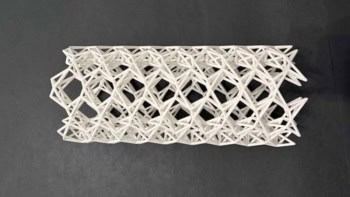
An important electronic property of graphene has been simulated for the first time using ultracold atoms. The experiment was carried out by physicists in Switzerland, who reproduced graphene’s distinctive “Dirac points” in a 2D honeycomb lattice produced by criss-crossing laser beams. The lattice contained potassium atoms, which played the role of electrons in graphene.
The shape of the lattice and the interactions between the atoms can be controlled by adjusting the lasers and applied magnetic fields. As a result, the technique can be used to investigate what happens to the electronic properties of graphene if its structure is modified – as well as simulating certain frustrated magnetic systems.
Getting to the Dirac point
As a 2D honeycomb of carbon atoms just one atom thick, graphene has a number of unique electronic properties that arise because of its lattice structure. In particular, graphene is a “zero-gap” semiconductor, which means that its electron valence and conduction bands just touch each other – in contrast to conventional semiconductors, which have an energy gap between the bands. Where the bands touch, the relationship between the energy and momentum of the electrons is similar to that of a photon, with the electrons moving at a very high speed approaching an effective speed of light. This behaviour is described by the Dirac equation for relativistic electrons, which is why this part of graphene’s band structure is called a Dirac point.
In 2011 physicists at the University of Hamburg in Germany managed to create the first honeycomb optical lattice, which they filled with rubidium-87 atoms. However, they were unable to see any evidence for Dirac points. Now, Tilman Esslinger and colleagues at the Institute for Quantum Optics at ETH Zurich have created a honeycomb optical lattice loaded with potassium-40 atoms and have found evidence for two Dirac points.
This measurement begins with a gas of several hundred-thousand potassium-40 atoms cooled to about 100 nK by allowing the most energetic atoms to escape, leaving only cool lethargic atoms behind. A square optical lattice is then created using two laser beams at the same wavelength that cross at 90° and interfere with each other. A third beam at a slightly different wavelength is then fired parallel to one of the two beams to create a standing wave, such that the relative positions of the square lattice and the standing wave can be controlled by adjusting the wavelength of the third beam. This allows the lattice to be manipulated into a range of different of patterns, including a honeycomb.
Such a lattice is expected to have two distinct Dirac points, which the team confirmed by accelerating the atoms using a magnetic-field gradient and then measuring their trajectories. The latter is done by switching off the lasers and watching the free atoms fly through the vacuum chamber. The physicists found that when the atoms had certain values of momentum, they were able to move effortlessly between the valence and conduction bands – the telltale signature of two Dirac points.
Moving easily between bands
The team then turned its attention to the relationship between the symmetry of the lattice and the existence of the Dirac points. By distorting the honeycomb, the researchers could make the Dirac points move, merge and even vanish. Since the electronic properties of graphene and graphene-like materials depend on the nature of the Dirac points, such quantum simulation could point towards new materials with potentially useful electronic properties. “Using this method, it may become possible to simulate the electronic properties of materials long before they can be physically realized,” explains Esslinger.
The team is currently working on reducing the temperature of the lattice, which could allow it to be used to study the frustrated magnetic systems that occur in triangular lattices.
The work is described in Nature.



